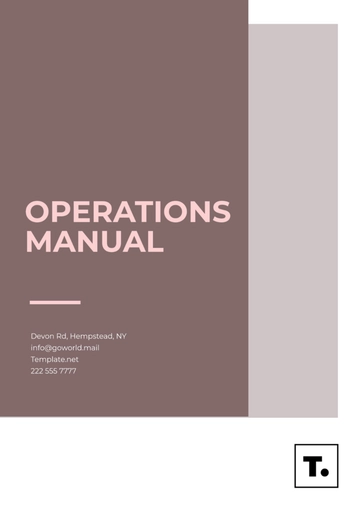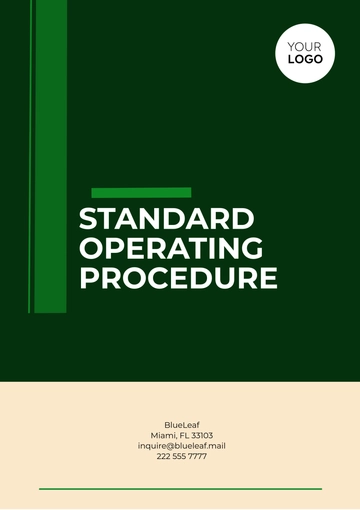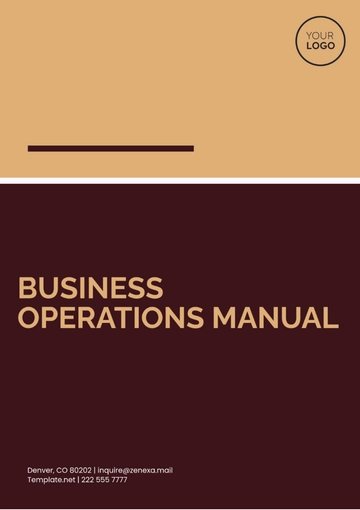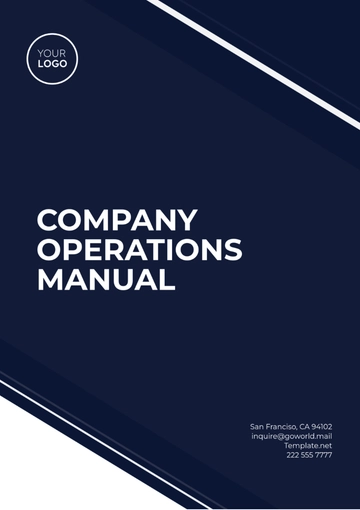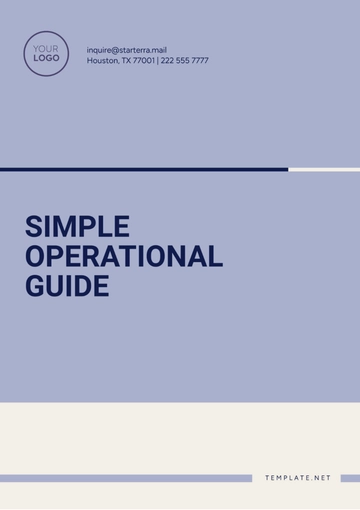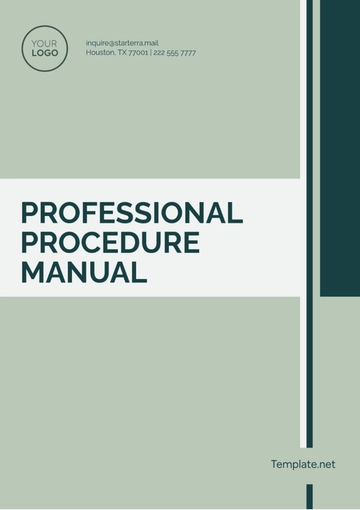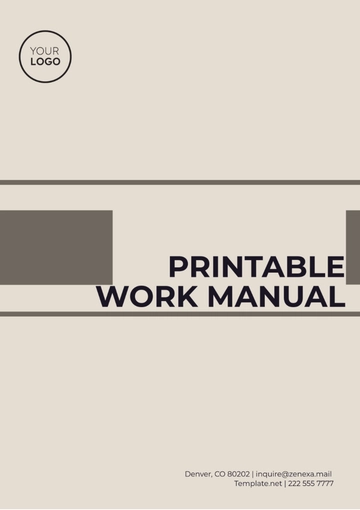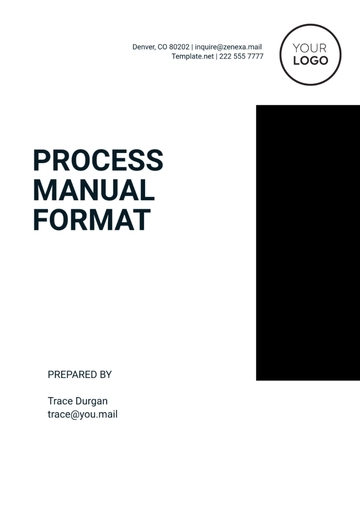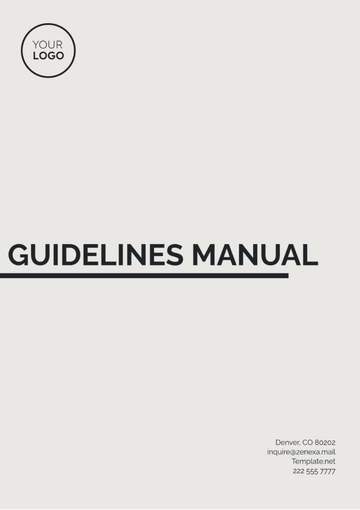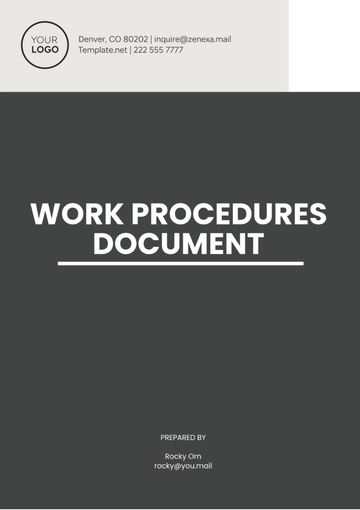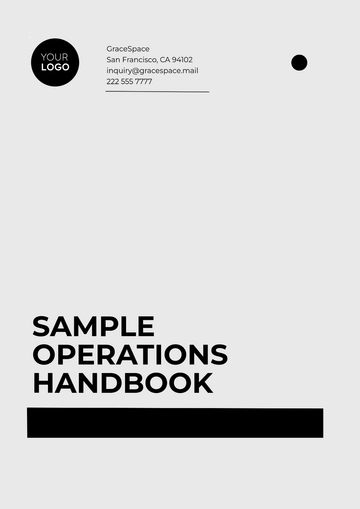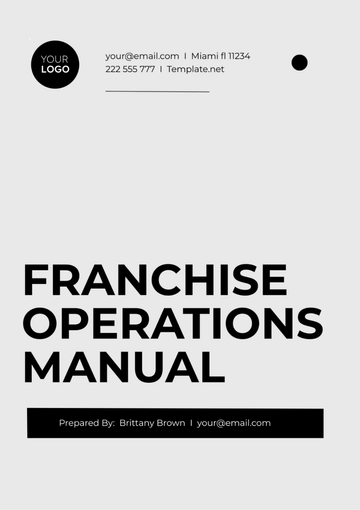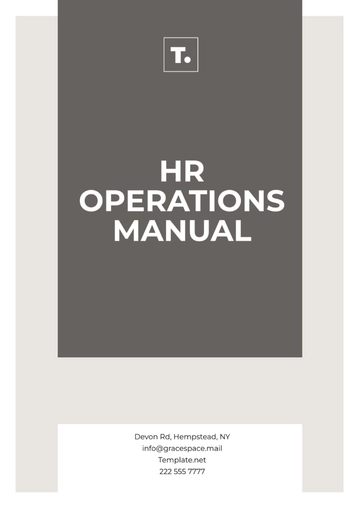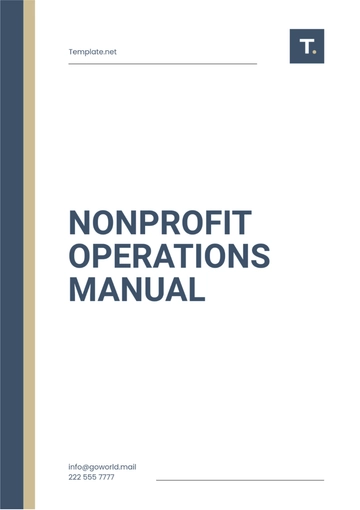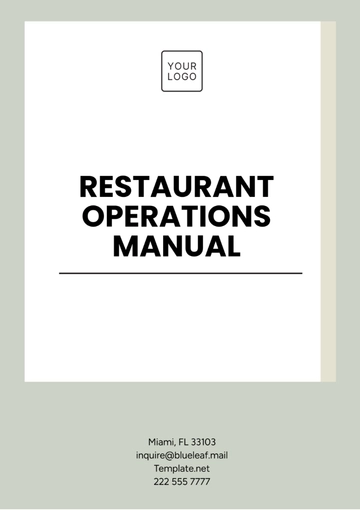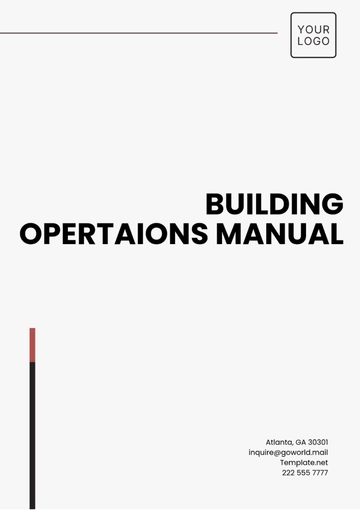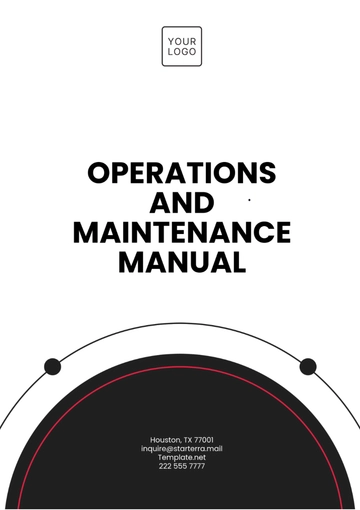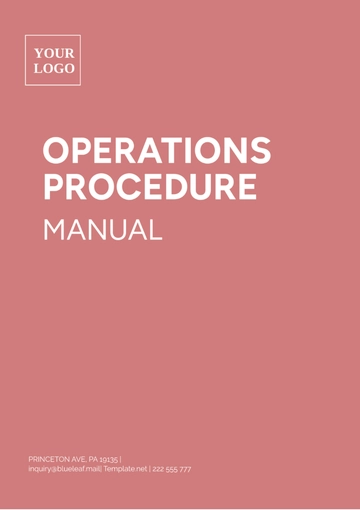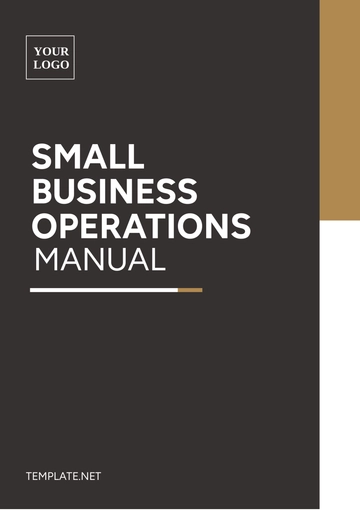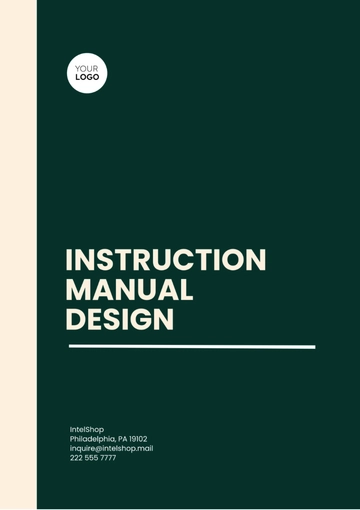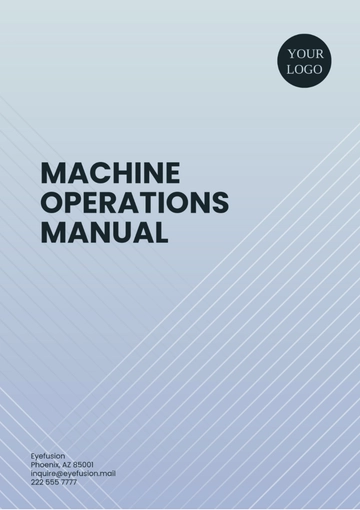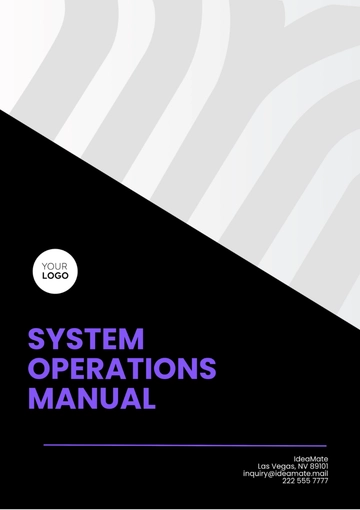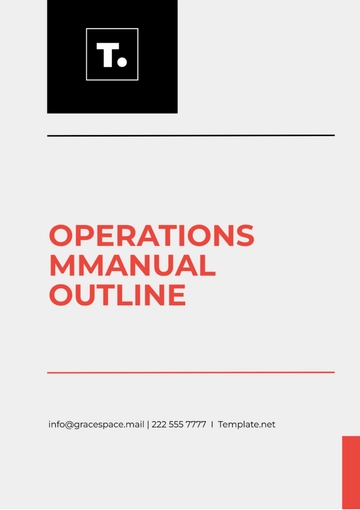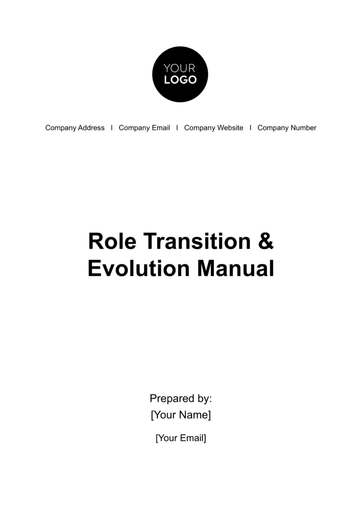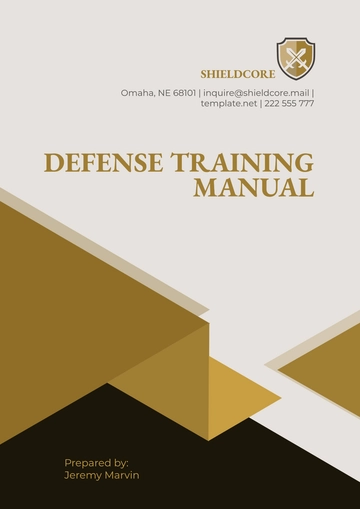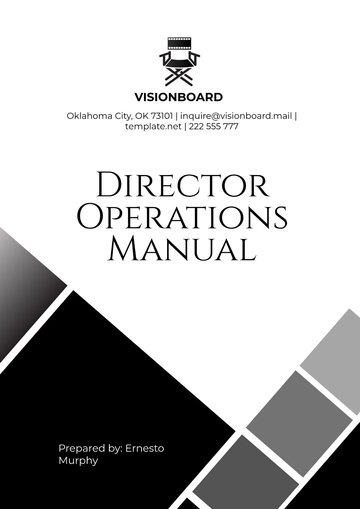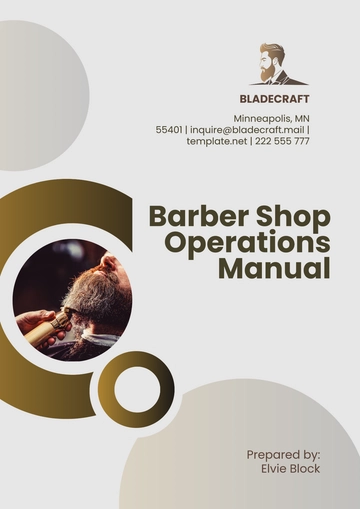Free Grocery Store Maintenance Manual

I. Introduction
A. Purpose
The purpose of this Grocery Store Maintenance Manual is to provide detailed guidelines for the upkeep and maintenance of [Your Company Name]. This manual aims to ensure that all maintenance activities are performed consistently and efficiently. Following this manual will help maintain the store's cleanliness, safety, and operational efficiency. It is essential for maintaining the store's overall appearance and functionality.
B. Scope
This manual covers all aspects of grocery store maintenance, including daily, weekly, and monthly tasks. It also includes procedures for handling emergencies and unexpected maintenance issues. The scope of this manual includes interior and exterior maintenance, equipment upkeep, and safety protocols. It is designed to address the needs of all store areas, from the sales floor to the stockroom.
C. Target Audience
The target audience for this maintenance manual is the employees of [Your Company Name]. This includes store managers, maintenance staff, and all other personnel responsible for maintaining the store. The manual provides clear instructions and procedures to ensure that all maintenance activities are carried out effectively. It is intended to be a comprehensive guide for all employees involved in store maintenance.
II. Daily Maintenance Procedures
The following table provides an overview of the daily maintenance procedures required to maintain the cleanliness and functionality of [Your Company Name]. These steps must be performed consistently to ensure a high standard of store maintenance.
No. | Step | Description |
|---|---|---|
1 | Floor Cleaning | Sweep and mop all store floors. |
2 | Trash Disposal | Empty all trash bins and replace liners. |
3 | Restroom Sanitation | Clean and sanitize restrooms. |
4 | Stock Shelves | Restock shelves and ensure proper display. |
5 | Equipment Check | Inspect and clean all equipment. |
6 | Customer Area Cleanliness | Ensure customer areas are clean and organized. |
7 | Produce Section Maintenance | Check and replenish produce section. |
A. Floor Cleaning
Sweeping: Sweep all store floors thoroughly to remove dirt and debris. This includes the sales floor, stockroom, and restrooms.
Mopping: Mop the floors using an appropriate cleaning solution to ensure they are clean and free of stains. Pay special attention to high-traffic areas.
Drying: Allow floors to dry completely to prevent slip hazards. Use wet floor signs to alert customers and staff of wet areas.
Inspection: Inspect the floors for any damage or areas that need additional cleaning. Report any issues to the maintenance supervisor.
Regular floor cleaning is essential for maintaining a clean and safe environment for customers and employees. Consistent sweeping, mopping, and drying help prevent accidents and improve the store's overall appearance.
B. Trash Disposal
Emptying Bins: Empty all trash bins throughout the store, including customer areas, restrooms, and stockrooms.
Replacing Liners: Replace trash bin liners to maintain cleanliness and prevent odors.
Disposal: Dispose of the trash in the designated outdoor bins. Ensure the bins are secured and not overflowing.
Inspection: Inspect trash bins for damage or cleanliness issues. Clean bins as needed and report any issues to the maintenance supervisor.
Proper trash disposal is crucial for maintaining a hygienic environment. Regularly emptying bins and replacing liners helps prevent odors and pest infestations, ensuring a pleasant shopping experience for customers.
C. Restroom Sanitation
Cleaning Fixtures: Clean and sanitize all restroom fixtures, including toilets, sinks, and mirrors.
Stocking Supplies: Ensure restrooms are stocked with necessary supplies, such as toilet paper, soap, and paper towels.
Trash Disposal: Empty restroom trash bins and replace liners.
Floor Cleaning: Sweep and mop restroom floors, paying special attention to corners and hard-to-reach areas.
Maintaining clean and well-stocked restrooms is essential for customer satisfaction. Regular cleaning and restocking help create a positive impression and ensure a hygienic environment for customers and employees.
D. Stock Shelves
Restocking: Restock shelves with products as needed, ensuring that items are neatly arranged and properly displayed.
Facing Products: Ensure all products are faced forward and labels are visible. This makes it easier for customers to find what they need.
Removing Damaged Goods: Remove any damaged or expired products from the shelves and report them to the supervisor for proper disposal.
Cleaning Shelves: Wipe down shelves to remove dust and spills, ensuring a clean and organized display.
Properly stocked and clean shelves enhance the shopping experience by making products easily accessible and visually appealing. Regular restocking and facing help maintain an orderly store appearance.
E. Equipment Check
Inspection: Inspect all store equipment, such as refrigerators, freezers, and checkout counters, for proper functioning.
Cleaning: Clean equipment surfaces to remove dust and debris. Ensure that refrigerated units are free of frost buildup.
Maintenance: Perform routine maintenance tasks, such as replacing filters or lubricating moving parts, as needed.
Reporting Issues: Report any equipment malfunctions or damage to the maintenance supervisor immediately.
Regular equipment checks are vital for preventing breakdowns and ensuring efficient store operations. Proper inspection, cleaning, and maintenance help extend the lifespan of equipment and maintain a safe shopping environment.
F. Customer Area Cleanliness
Tidying Areas: Ensure customer areas, such as aisles and checkout lanes, are tidy and free of clutter.
Wiping Surfaces: Wipe down surfaces, including counters and display tables, to maintain cleanliness.
Organizing Displays: Organize product displays to ensure they are neat and attractive.
Checking for Hazards: Regularly check for any potential hazards, such as spills or obstacles, and address them promptly.
Maintaining clean and organized customer areas enhances the shopping experience and ensures safety. Regular tidying, wiping, and organizing help create a welcoming environment for customers.
G. Produce Section Maintenance
Inspecting Produce: Inspect produce for freshness and quality. Remove any spoiled or damaged items.
Replenishing Stock: Replenish the produce section with fresh stock as needed.
Cleaning Displays: Clean produce displays to remove dirt and debris.
Arranging Items: Arrange produce items neatly to create an attractive and accessible display.
Proper maintenance of the produce section is crucial for ensuring the freshness and quality of products. Regular inspection, replenishing, and cleaning help create an appealing display and enhance customer satisfaction.
Effective daily maintenance procedures are essential for maintaining the cleanliness, safety, and overall functionality of [Your Company Name]. By following the guidelines outlined in this manual, employees can ensure that all areas of the store are well-maintained and provide a positive shopping experience for customers.
III. Weekly Maintenance Procedures
The following table provides an overview of the weekly maintenance procedures required to ensure the ongoing upkeep of [Your Company Name]. These tasks are essential for addressing maintenance needs that arise less frequently but are still critical for store operations.
No. | Step | Description |
|---|---|---|
1 | Deep Cleaning | Perform a thorough cleaning of all store areas. |
2 | Equipment Maintenance | Conduct detailed inspections and maintenance. |
3 | Inventory Check | Perform a comprehensive inventory check. |
4 | Restroom Deep Clean | Conduct a deep cleaning of restrooms. |
5 | Stockroom Organization | Organize and clean the stockroom. |
6 | Exterior Maintenance | Maintain the exterior of the store. |
7 | Safety Inspection | Conduct a safety inspection of the store. |
A. Deep Cleaning
Floor Cleaning: Perform a deep clean of all store floors, including scrubbing and waxing as needed.
High Dusting: Dust high surfaces, such as shelves and light fixtures, to remove accumulated dust.
Window Cleaning: Clean all windows and glass surfaces to ensure they are streak-free and clear.
Display Cleaning: Clean and sanitize all display areas, including shelves and counters.
Weekly deep cleaning is essential for maintaining a high standard of cleanliness in the store. Thorough cleaning of floors, high surfaces, windows, and displays helps create a pleasant shopping environment and ensures the store remains in top condition.
B. Equipment Maintenance
Inspection: Conduct a detailed inspection of all equipment to identify any potential issues.
Cleaning: Clean equipment thoroughly, including internal components and filters.
Lubrication: Lubricate moving parts as needed to ensure smooth operation.
Repair: Perform minor repairs and adjustments to equipment as necessary.
Regular equipment maintenance helps prevent breakdowns and extends the lifespan of store equipment. Thorough inspections, cleaning, lubrication, and minor repairs ensure that all equipment functions efficiently and safely.
C. Inventory Check
Stock Counting: Perform a comprehensive count of all inventory items to ensure accuracy.
Discrepancy Resolution: Identify and resolve any discrepancies between recorded and actual inventory levels.
Stock Rotation: Rotate stock to ensure that older items are sold first, reducing the risk of spoilage.
Order Adjustment: Adjust order quantities based on inventory levels and sales trends.
Conducting a weekly inventory check helps maintain accurate stock levels and prevents overstocking or stockouts. Resolving discrepancies, rotating stock, and adjusting orders ensure efficient inventory management.
D. Restroom Deep Clean
Fixture Cleaning: Perform a deep clean of all restroom fixtures, including toilets, sinks, and mirrors.
Floor Scrubbing: Scrub restroom floors to remove stains and buildup.
Disinfecting Surfaces: Disinfect all restroom surfaces, including walls and partitions.
Restocking Supplies: Ensure restrooms are fully stocked with necessary supplies.
A weekly deep clean of restrooms is essential for maintaining hygiene and customer satisfaction. Thorough cleaning, scrubbing, disinfecting, and restocking ensure that restrooms remain clean and sanitary.
E. Stockroom Organization
Shelf Cleaning: Clean and organize stockroom shelves to ensure easy access to products.
Labeling: Label shelves and storage areas to improve organization and efficiency.
Inventory Arrangement: Arrange inventory items neatly and in an organized manner.
Floor Cleaning: Sweep and mop the stockroom floor to maintain cleanliness.
Maintaining an organized and clean stockroom is crucial for efficient store operations. Regular cleaning, labeling, and arranging of inventory items ensure that products are easily accessible and the stockroom remains in good condition.
F. Exterior Maintenance
Trash Removal: Remove any trash or debris from the exterior of the store.
Window Cleaning: Clean exterior windows to ensure they are streak-free and clear.
Landscape Maintenance: Maintain any landscaping around the store, including trimming bushes and mowing grass.
Parking Lot Cleaning: Sweep and clean the parking lot to remove dirt and debris.
Regular exterior maintenance is essential for creating a positive first impression for customers. Keeping the exterior clean and well-maintained enhances the overall appearance of the store and ensures a welcoming environment.
G. Safety Inspection
Hazard Identification: Identify any potential safety hazards in the store and take corrective action.
Fire Safety Check: Ensure that fire safety equipment, such as extinguishers and alarms, is in working order.
Emergency Exits: Verify that emergency exits are clear and accessible.
Employee Training: Conduct training sessions on safety protocols and emergency procedures.
Conducting regular safety inspections helps prevent accidents and ensures a safe environment for customers and employees. Identifying hazards, checking fire safety equipment, ensuring clear emergency exits, and providing employee training are critical components of safety management.
Effective weekly maintenance procedures are essential for maintaining the cleanliness, safety, and overall functionality of [Your Company Name]. By following the guidelines outlined in this manual, employees can ensure that all areas of the store are well-maintained and provide a positive shopping experience for customers.
IV. Monthly Maintenance Procedures
The following table provides an overview of the monthly maintenance procedures required to ensure the long-term upkeep of [Your Company Name]. These tasks address maintenance needs that arise less frequently but are still critical for store operations.
No. | Step | Description |
|---|---|---|
1 | HVAC Maintenance | Inspect and service HVAC systems. |
2 | Deep Clean of Refrigeration Units | Perform a thorough cleaning of all refrigeration units. |
3 | Pest Control | Conduct a comprehensive pest control treatment. |
4 | Lighting Inspection | Inspect and replace any faulty lighting. |
5 | Plumbing Check | Inspect plumbing systems and perform necessary repairs. |
6 | Fire Safety Equipment Check | Inspect and service all fire safety equipment. |
A. HVAC Maintenance
Filter Replacement: Replace HVAC filters to ensure optimal air quality and system efficiency.
System Inspection: Conduct a thorough inspection of HVAC systems to identify any potential issues.
Cleaning: Clean HVAC components, including vents and coils, to remove dust and debris.
Repairs: Perform any necessary repairs to ensure the HVAC system operates efficiently.
Regular HVAC maintenance is essential for maintaining a comfortable shopping environment. Replacing filters, inspecting systems, cleaning components, and performing repairs help ensure that the HVAC system operates efficiently and effectively.
B. Deep Clean of Refrigeration Units
Internal Cleaning: Clean the interior of all refrigeration units to remove spills and debris.
Defrosting: Defrost units to remove any ice buildup and ensure proper operation.
Temperature Check: Verify that refrigeration units are maintaining the correct temperatures.
Seal Inspection: Inspect and replace any worn or damaged seals to maintain efficiency.
Monthly deep cleaning of refrigeration units is crucial for maintaining food safety and efficiency. Cleaning interiors, defrosting, checking temperatures, and inspecting seals ensure that refrigeration units operate effectively.
C. Pest Control
Inspection: Conduct a thorough inspection of the store to identify any signs of pest activity.
Treatment: Apply pest control treatments to eliminate any pests and prevent infestations.
Prevention: Implement preventive measures, such as sealing entry points and maintaining cleanliness, to deter pests.
Follow-Up: Schedule follow-up inspections and treatments as needed to ensure ongoing pest control.
Regular pest control is essential for maintaining a hygienic environment and preventing damage to products. Inspections, treatments, preventive measures, and follow-ups help ensure effective pest management.
D. Lighting Inspection
Inspection: Inspect all store lighting to identify any faulty or flickering lights.
Replacement: Replace any burnt-out or faulty bulbs to maintain proper lighting levels.
Cleaning: Clean light fixtures to remove dust and improve brightness.
Efficiency Check: Verify that energy-efficient lighting is being used to reduce energy costs.
Monthly lighting inspections and maintenance help ensure a well-lit and safe shopping environment. Replacing faulty bulbs, cleaning fixtures, and using energy-efficient lighting contribute to improved store operations.
E. Plumbing Check
Inspection: Inspect all plumbing systems, including sinks, toilets, and drains, for any issues.
Leak Detection: Check for leaks and perform necessary repairs to prevent water damage.
Drain Cleaning: Clean drains to prevent clogs and ensure proper drainage.
Fixture Maintenance: Maintain plumbing fixtures to ensure they operate efficiently.
Regular plumbing checks are essential for preventing water damage and ensuring proper functioning of plumbing systems. Inspections, leak detection, drain cleaning, and fixture maintenance help maintain a safe and efficient store environment.
F. Fire Safety Equipment Check
Inspection: Inspect all fire safety equipment, including extinguishers, alarms, and sprinklers, to ensure they are in working order.
Maintenance: Perform necessary maintenance on fire safety equipment to ensure functionality.
Replacement: Replace any expired or faulty fire safety equipment.
Training: Conduct training sessions for employees on the use of fire safety equipment.
Monthly fire safety equipment checks are crucial for maintaining a safe environment and ensuring compliance with safety regulations. Inspections, maintenance, replacements, and training help ensure that fire safety equipment is ready for use in an emergency.
Effective monthly maintenance procedures are essential for maintaining the long-term functionality and safety of [Your Company Name]. By following the guidelines outlined in this manual, employees can ensure that all areas of the store are well-maintained and provide a positive shopping experience for customers.
V. Emergency Maintenance Procedures
A. Power Outage Response
Immediate Actions: Turn off all non-essential electrical equipment to prevent damage when power is restored.
Communication: Inform all employees of the power outage and provide instructions for safe conduct.
Backup Systems: Activate backup power systems, such as generators, to maintain essential functions.
Safety Check: Ensure that all emergency lighting and safety systems are functioning.
Quick and effective responses to power outages are essential for maintaining safety and minimizing disruption. Turning off equipment, communicating with employees, activating backup systems, and checking safety systems help manage power outages effectively.
B. Plumbing Emergency
Shut Off Water: Immediately shut off the main water supply to prevent further damage.
Containment: Contain any water leaks using buckets, towels, or other materials.
Report: Report the issue to the maintenance supervisor and call a plumber if necessary.
Cleanup: Clean up any water to prevent slips and further damage.
Effective responses to plumbing emergencies are crucial for preventing water damage and maintaining safety. Shutting off water, containing leaks, reporting the issue, and cleaning up water help manage plumbing emergencies efficiently.
C. Refrigeration Unit Failure
Move Products: Move perishable products to alternative refrigeration units to prevent spoilage.
Report: Report the issue to the maintenance supervisor and call a technician if necessary.
Inspect Unit: Inspect the refrigeration unit to identify any obvious issues.
Document: Document the failure and actions taken for future reference.
Quick and effective responses to refrigeration unit failures are essential for preventing product spoilage and maintaining food safety. Moving products, reporting the issue, inspecting the unit, and documenting the failure help manage refrigeration unit failures efficiently.
D. Fire Emergency
Evacuate: Evacuate all employees and customers from the building immediately.
Activate Alarm: Activate the fire alarm to alert others and contact emergency services.
Use Extinguishers: Use fire extinguishers to attempt to put out small fires, if safe to do so.
Report: Report the fire to the maintenance supervisor and document the incident.
Effective responses to fire emergencies are crucial for ensuring the safety of employees and customers. Evacuating the building, activating alarms, using extinguishers, and reporting the fire help manage fire emergencies effectively.
E. Security Breach
Secure Area: Secure the affected area and prevent unauthorized access.
Inform Authorities: Inform local authorities and provide details of the breach.
Notify Employees: Notify all employees of the breach and provide instructions for safety.
Document: Document the breach and actions taken for future reference.
Quick and effective responses to security breaches are essential for maintaining safety and preventing further incidents. Securing the area, informing authorities, notifying employees, and documenting the breach help manage security breaches efficiently.
Effective emergency maintenance procedures are essential for ensuring the safety and functionality of [Your Company Name]. By following the guidelines outlined in this manual, employees can respond quickly and effectively to unexpected issues, minimizing disruption and maintaining a safe environment.
VI. Equipment Maintenance Schedule
The following table provides an overview of the equipment maintenance schedule for [Your Company Name]. Regular maintenance of equipment is essential for ensuring efficient and safe store operations.
No. | Equipment | Maintenance Task | Frequency |
|---|---|---|---|
1 | Refrigeration Units | Inspect and clean coils | Monthly |
2 | HVAC Systems | Replace filters and inspect system | Monthly |
3 | Checkout Counters | Inspect and clean | Weekly |
4 | Freezers | Defrost and clean | Monthly |
5 | Shelving Units | Inspect for damage and clean | Monthly |
6 | Fire Extinguishers | Inspect and service | Quarterly |
7 | Lighting Fixtures | Inspect and replace faulty bulbs | Monthly |
A. Refrigeration Units
Coil Cleaning: Clean the coils to ensure efficient operation and prevent overheating.
Temperature Check: Verify that the refrigeration units are maintaining the correct temperatures.
Seal Inspection: Inspect and replace any worn or damaged seals to maintain efficiency.
Fan Maintenance: Check and clean the fans to ensure proper airflow.
Regular maintenance of refrigeration units is essential for preventing breakdowns and ensuring food safety. Cleaning coils, checking temperatures, inspecting seals, and maintaining fans help ensure efficient operation.
B. HVAC Systems
Filter Replacement: Replace HVAC filters to ensure optimal air quality and system efficiency.
System Inspection: Conduct a thorough inspection of HVAC systems to identify any potential issues.
Cleaning: Clean HVAC components, including vents and coils, to remove dust and debris.
Repairs: Perform any necessary repairs to ensure the HVAC system operates efficiently.
Regular HVAC maintenance is essential for maintaining a comfortable shopping environment. Replacing filters, inspecting systems, cleaning components, and performing repairs help ensure that the HVAC system operates efficiently and effectively.
C. Checkout Counters
Surface Cleaning: Clean the surface of checkout counters to maintain cleanliness and hygiene.
Equipment Check: Inspect checkout equipment, such as scanners and card readers, for proper functioning.
Drawer Maintenance: Clean and lubricate cash drawers to ensure smooth operation.
Signage Inspection: Inspect and clean any signage at the checkout counters.
Regular maintenance of checkout counters is essential for ensuring efficient and hygienic customer service. Cleaning surfaces, checking equipment, maintaining cash drawers, and inspecting signage help ensure smooth checkout operations.
D. Freezers
Defrosting: Defrost freezers to remove any ice buildup and ensure proper operation.
Internal Cleaning: Clean the interior of freezers to remove spills and debris.
Temperature Check: Verify that freezers are maintaining the correct temperatures.
Seal Inspection: Inspect and replace any worn or damaged seals to maintain efficiency.
Regular maintenance of freezers is crucial for maintaining food safety and efficiency. Defrosting, cleaning interiors, checking temperatures, and inspecting seals ensure that freezers operate effectively.
E. Shelving Units
Inspection: Inspect shelving units for any damage or instability.
Cleaning: Clean shelves to remove dust and spills, ensuring a clean and organized display.
Labeling: Ensure that shelves are properly labeled for efficient product placement.
Repair: Perform any necessary repairs to maintain the integrity of shelving units.
Regular maintenance of shelving units is essential for ensuring a neat and organized store. Inspecting for damage, cleaning, labeling, and performing repairs help maintain the functionality and appearance of shelving units.
F. Fire Extinguishers
Inspection: Inspect fire extinguishers to ensure they are in working order.
Maintenance: Perform necessary maintenance, such as checking pressure levels and replacing components.
Replacement: Replace any expired or faulty fire extinguishers.
Training: Conduct training sessions for employees on the use of fire extinguishers.
Regular maintenance of fire extinguishers is crucial for maintaining a safe environment and ensuring compliance with safety regulations. Inspections, maintenance, replacements, and training help ensure that fire extinguishers are ready for use in an emergency.
G. Lighting Fixtures
Inspection: Inspect all lighting fixtures to identify any faulty or flickering lights.
Replacement: Replace any burnt-out or faulty bulbs to maintain proper lighting levels.
Cleaning: Clean light fixtures to remove dust and improve brightness.
Efficiency Check: Verify that energy-efficient lighting is being used to reduce energy costs.
Regular maintenance of lighting fixtures helps ensure a well-lit and safe shopping environment. Replacing faulty bulbs, cleaning fixtures, and using energy-efficient lighting contribute to improved store operations.
Effective equipment maintenance is essential for maintaining the efficiency and safety of [Your Company Name]. By following the guidelines outlined in this manual, employees can ensure that all equipment is well-maintained and operates effectively.
VII. Safety Protocols
A. Emergency Evacuation Plan
Evacuation Routes: Clearly mark and communicate evacuation routes to all employees and customers.
Assembly Points: Designate assembly points outside the store where employees and customers should gather.
Drills: Conduct regular evacuation drills to ensure everyone is familiar with the procedures.
Communication: Ensure that emergency contact information is readily available and communicated to all employees.
An effective emergency evacuation plan is crucial for ensuring the safety of employees and customers during emergencies. Clearly marked routes, designated assembly points, regular drills, and effective communication help manage evacuations efficiently.
B. Fire Safety Protocol
Fire Prevention: Implement measures to prevent fires, such as proper storage of flammable materials and regular inspections of electrical systems.
Extinguisher Training: Provide training for employees on the proper use of fire extinguishers.
Alarm System: Ensure that fire alarm systems are functioning correctly and regularly tested.
Evacuation Plan: Develop and communicate a fire evacuation plan to all employees.
Adhering to fire safety protocols is essential for preventing fires and ensuring a quick and effective response if one occurs. Fire prevention measures, extinguisher training, functional alarm systems, and a clear evacuation plan help maintain a safe environment.
C. Hazardous Material Handling
Storage: Store hazardous materials in designated areas, away from food and customer access.
Labeling: Clearly label all hazardous materials to ensure proper handling and storage.
Protective Equipment: Provide employees with appropriate protective equipment when handling hazardous materials.
Training: Conduct regular training sessions on the safe handling and disposal of hazardous materials.
Proper handling of hazardous materials is crucial for maintaining a safe environment. Safe storage, clear labeling, protective equipment, and regular training help ensure that hazardous materials are managed effectively.
D. Slip and Fall Prevention
Floor Maintenance: Regularly clean and maintain floors to prevent slips and falls.
Wet Floor Signs: Use wet floor signs to alert customers and employees of wet or slippery areas.
Spill Management: Promptly clean up any spills and ensure the area is dry and safe.
Inspection: Conduct regular inspections to identify and address potential hazards.
Preventing slip and fall accidents is essential for maintaining a safe environment. Proper floor maintenance, use of wet floor signs, prompt spill management, and regular inspections help reduce the risk of accidents.
E. First Aid Procedures
First Aid Kits: Ensure that first aid kits are readily available and fully stocked.
Training: Provide first aid training to employees so they can respond effectively to injuries.
Emergency Contacts: Maintain a list of emergency contacts and provide it to all employees.
Incident Reporting: Implement a system for reporting and documenting injuries and incidents.
Effective first aid procedures are crucial for responding to injuries and maintaining a safe environment. Readily available first aid kits, trained employees, emergency contacts, and incident reporting help manage injuries effectively.
F. Security Procedures
Access Control: Implement measures to control access to sensitive areas of the store.
Surveillance: Use surveillance systems to monitor store activities and deter theft.
Alarm Systems: Ensure that security alarm systems are functioning correctly and regularly tested.
Employee Training: Provide training to employees on security protocols and procedures.
Adhering to security procedures is essential for preventing theft and maintaining a safe environment. Access control, surveillance, functional alarm systems, and employee training help ensure effective security management.
Effective safety protocols are essential for maintaining a safe environment for employees and customers at [Your Company Name]. By following the guidelines outlined in this manual, employees can ensure that safety measures are implemented and maintained effectively.
VIII. Frequently Asked Questions (FAQs)
Q: How often should refrigeration units be inspected?
A: Refrigeration units should be inspected monthly. This ensures that any issues are identified early and maintenance is performed as needed to keep the units operating efficiently.Q: What should I do if I notice a leak in the HVAC system?
A: If you notice a leak in the HVAC system, report it immediately to the maintenance supervisor. A technician will need to inspect and repair the system to prevent further damage.Q: How can I prevent slip and fall accidents in the store?
A: Prevent slip and fall accidents by regularly cleaning floors, using wet floor signs, and promptly addressing any spills. Regular inspections can also help identify and address potential hazards.Q: What steps should be taken during a fire emergency?
A: During a fire emergency, evacuate all employees and customers, activate the fire alarm, use fire extinguishers if safe, and report the incident to the maintenance supervisor.Q: How often should fire extinguishers be inspected?
A: Fire extinguishers should be inspected quarterly. This includes checking pressure levels, replacing any components as necessary, and ensuring they are in good working order.Q: What is the procedure for handling hazardous materials?
A: Hazardous materials should be stored in designated areas, clearly labeled, and handled with appropriate protective equipment. Employees should also receive regular training on safe handling practices.Q: How do I report a maintenance issue in the store?
A: Report maintenance issues to the maintenance supervisor immediately. Provide details about the problem so that it can be addressed quickly and efficiently.Q: What should I include in the documentation of a maintenance failure?
A: Documentation of a maintenance failure should include a description of the issue, the steps taken to address it, and any impact on store operations. This helps in analyzing and preventing future occurrences.Q: How often should checkout counters be cleaned?
A: Checkout counters should be cleaned weekly. Regular cleaning helps maintain hygiene and ensures that the equipment remains in good working condition.Q: What are the key components of an effective emergency evacuation plan?
A: An effective emergency evacuation plan includes clearly marked evacuation routes, designated assembly points, regular evacuation drills, and accessible emergency contact information for all employees.
- 100% Customizable, free editor
- Access 1 Million+ Templates, photo’s & graphics
- Download or share as a template
- Click and replace photos, graphics, text, backgrounds
- Resize, crop, AI write & more
- Access advanced editor
Maintain your store's operations smoothly with the Grocery Store Maintenance Manual Template! Its customizable design allows you to tailor it to your store's specific maintenance needs. The AI Editor Tool helps you create a comprehensive and effective manual. Available on Template.net, this template is editable for easy updates and adjustments!
